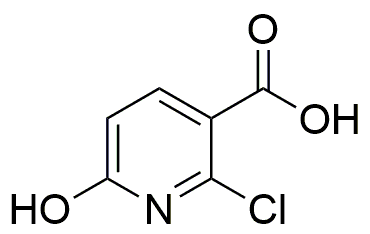2-Chloro-6-hydroxynicotinic acid is widely utilized in research focused on:
- Pharmaceutical Development: This compound serves as a key intermediate in the synthesis of various pharmaceuticals, particularly those targeting neurological disorders, enhancing drug efficacy and specificity.
- Agricultural Chemistry: It is used in the formulation of herbicides and pesticides, helping to improve crop yields by effectively managing weed populations while minimizing environmental impact.
- Biochemical Research: The compound is valuable in studies related to enzyme inhibition and receptor binding, providing insights into metabolic pathways and potential therapeutic targets.
- Analytical Chemistry: It acts as a standard reference material in chromatographic techniques, ensuring accurate quantification of similar compounds in complex mixtures.
- Material Science: This chemical is explored in the development of novel materials, such as polymers and coatings, which exhibit enhanced properties like durability and resistance to degradation.
General Information
Properties
Safety and Regulations
Applications
2-Chloro-6-hydroxynicotinic acid is widely utilized in research focused on:
- Pharmaceutical Development: This compound serves as a key intermediate in the synthesis of various pharmaceuticals, particularly those targeting neurological disorders, enhancing drug efficacy and specificity.
- Agricultural Chemistry: It is used in the formulation of herbicides and pesticides, helping to improve crop yields by effectively managing weed populations while minimizing environmental impact.
- Biochemical Research: The compound is valuable in studies related to enzyme inhibition and receptor binding, providing insights into metabolic pathways and potential therapeutic targets.
- Analytical Chemistry: It acts as a standard reference material in chromatographic techniques, ensuring accurate quantification of similar compounds in complex mixtures.
- Material Science: This chemical is explored in the development of novel materials, such as polymers and coatings, which exhibit enhanced properties like durability and resistance to degradation.
Documents
Safety Data Sheets (SDS)
The SDS provides comprehensive safety information on handling, storage, and disposal of the product.
Product Specification (PS)
The PS provides a comprehensive breakdown of the product’s properties, including chemical composition, physical state, purity, and storage requirements. It also details acceptable quality ranges and the product's intended applications.
Certificates of Analysis (COA)
Search for Certificates of Analysis (COA) by entering the products Lot Number. Lot and Batch Numbers can be found on a product’s label following the words ‘Lot’ or ‘Batch’.
Número de catálogo
Número de lote/lote
Certificates Of Origin (COO)
This COO confirms the country where the product was manufactured, and also details the materials and components used in it and whether it is derived from natural, synthetic, or other specific sources. This certificate may be required for customs, trade, and regulatory compliance.
Número de catálogo
Número de lote/lote
Safety Data Sheets (SDS)
The SDS provides comprehensive safety information on handling, storage, and disposal of the product.
DownloadProduct Specification (PS)
The PS provides a comprehensive breakdown of the product’s properties, including chemical composition, physical state, purity, and storage requirements. It also details acceptable quality ranges and the product's intended applications.
DownloadCertificates of Analysis (COA)
Search for Certificates of Analysis (COA) by entering the products Lot Number. Lot and Batch Numbers can be found on a product’s label following the words ‘Lot’ or ‘Batch’.
Número de catálogo
Número de lote/lote
Certificates Of Origin (COO)
This COO confirms the country where the product was manufactured, and also details the materials and components used in it and whether it is derived from natural, synthetic, or other specific sources. This certificate may be required for customs, trade, and regulatory compliance.


